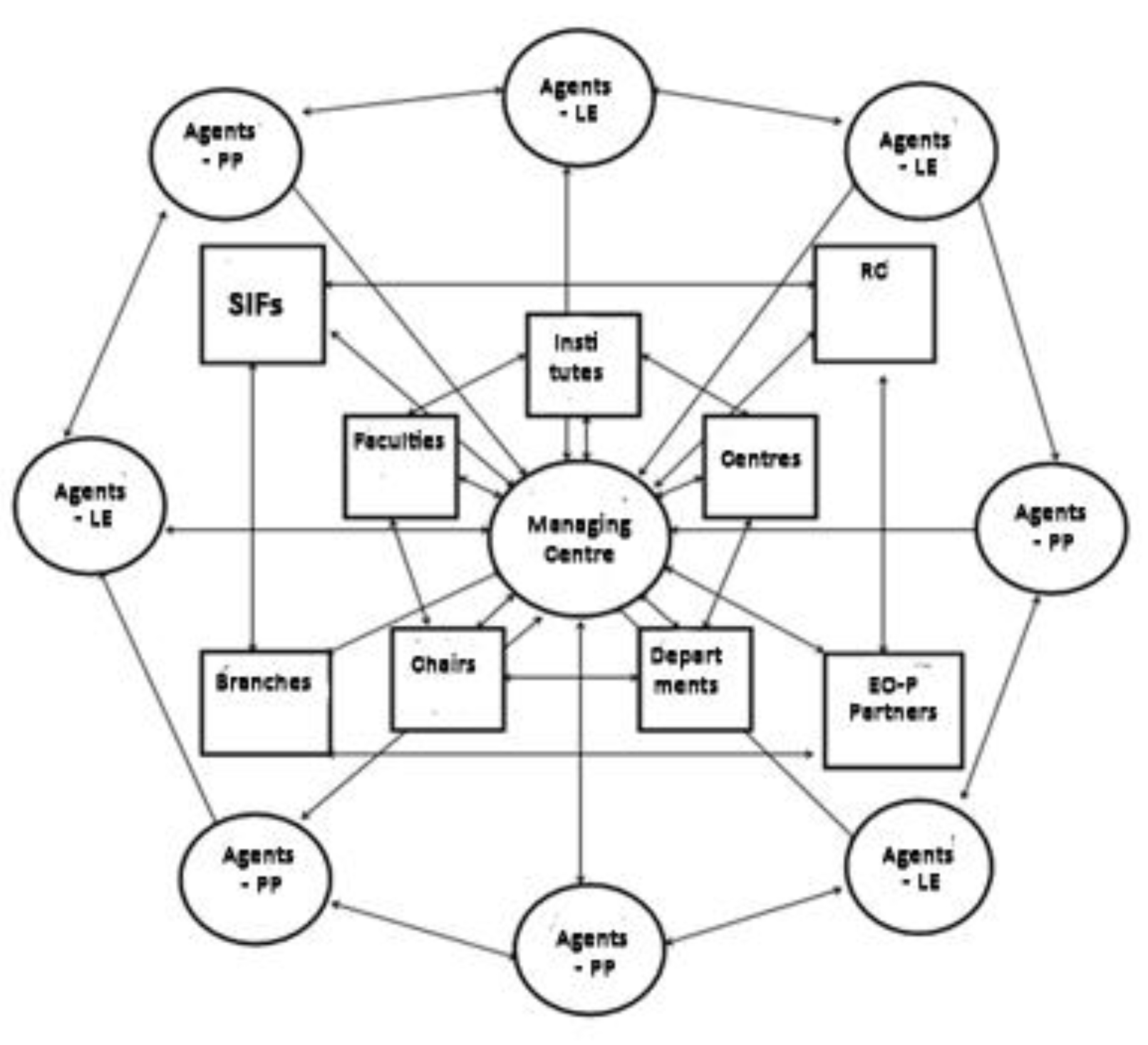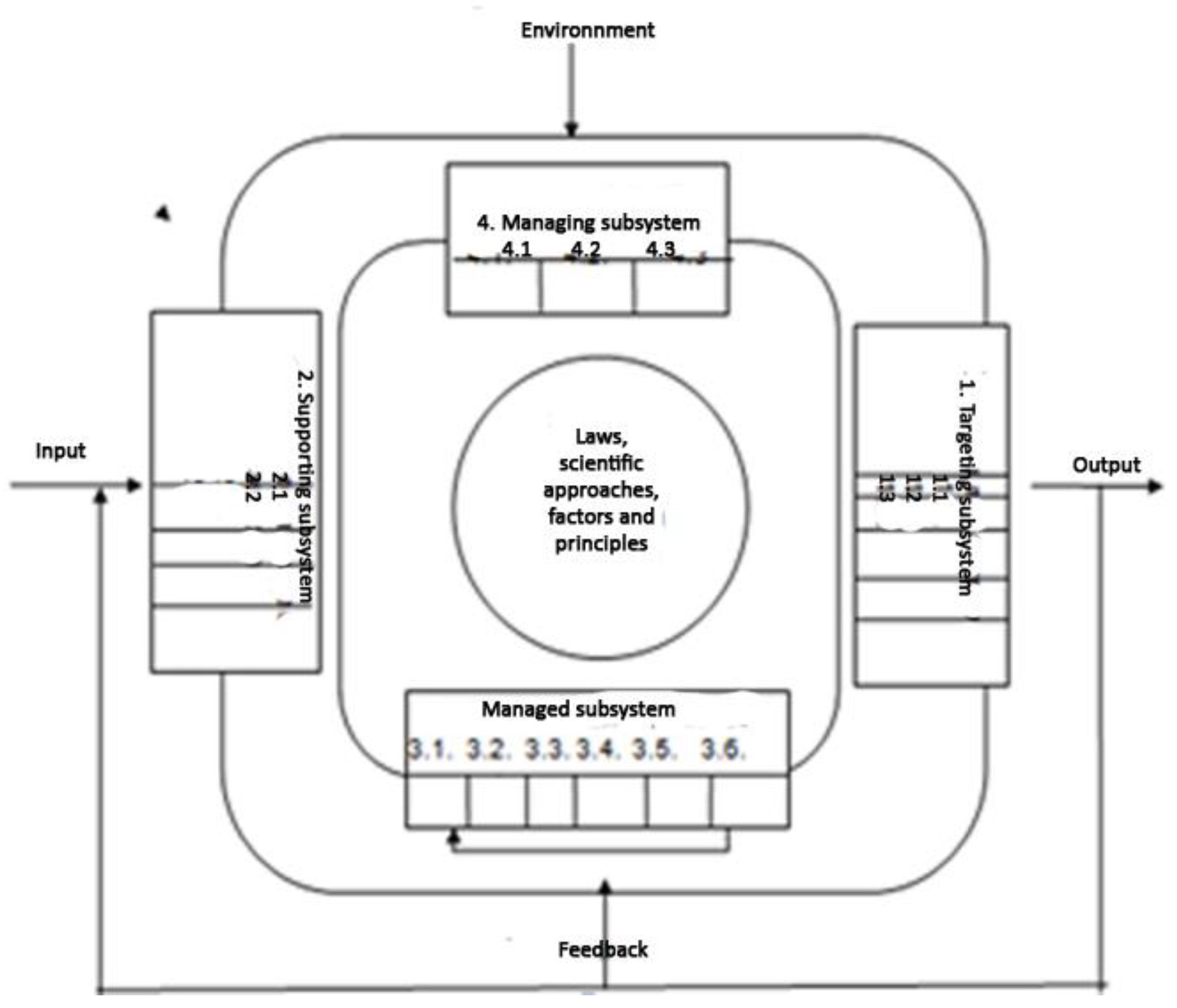Management system of network self-learning organization of additional professional education
ˑ:
Academician, Dr.Sc.Econ., professor, alternate director A.I. Tayurskiy 1
Ph.D., Associate Professor E.N. Belova 2
1 Institute of the Problems of Continuing Education of the Russian Academy of Education, Krasnoyarsk
2 Krasnoyarsk State Pedagogical University named after V.P. Astafiev, Krasnoyarsk
Keywords: management infrastructure, additional professional education in physical education and sport, network self-learning organization, triple network.
Introduction. Further development of additional professional education (APE) as the most important component of continuous professional education in the field of physical education and sport is associated with realization of integration processes and implementation of innovative educational management aimed to reform the APE system in accordance with contemporary challenges. The necessity to increase the competitiveness of the APE system grows making apparent the importance of finding conditions that facilitate creation of an innovative organizational form of effective development of the system of network self-learning organization of APE in physical education and sport [4, 5, 6].
We consider effective management of the APE system to be among conditions that improve the competitiveness of APE organizations in physical education and sport. This makes the problem of developing and describing the management system of network self-learning organization of APE (NSLO of APE) significant, and this research project is aimed to solve it.
Research methods and organization. The main research methods were conceptual and systems analysis, modelling, observation and expert evaluation of representative statements by researchers, modern managers and specialists in the field of problems related to the APE management infrastructure.
Let us examine the essence and content of the concept “infrastructure”. Traditionally the concept “infrastructure” (from Latin Infra – below and struktura –structure, location) means buildings, constructions, systems and services that are required for branches of material production and society to function. There is production infrastructure (roads, canals, ports, warehouses, communication systems, et al.) Sometimes infrastructure denotes a complex of so-called infrastructural sectors of economy (transport, communication, education, healthcare et al.) [2, 9]. The ISO standard “Risk Management. Principles and Guidelines” contains a concept of risk management infrastructure (risk management framework), which is distinguished as a set of components that provide foundation, organizational means and structure for development, implementation, monitoring, review and constant improvement of risk management in the scope of an organization as a whole [3].
We understand the infrastructure of management system as a sum of many factors that constitute the social and economic environment, in which Russian management functions. It is a complex of interrelated, supporting structures that constitute or secure the foundation for management problem (objective) solution [1, 7, 8] and represent certain subsystems.
Results and discussion. In our opinion, an NSLO of APE allowing increasing profits from implementation of programmes and improving the quality of programme development and implementation by continuous development of intellectual resource of this organization can become an effective organizational structure that make competitive the Russian system of APE in the field of physical education and sport.
We consider a network self-learning organization of APE as a new type of flexible organizational structure that is able to promptly react and adapt to present-day challenges of education market, produce and distribute new knowledge within itself. The NSLO of APE represents integrative education of different subjects of the network providing conditions for individual, team-based and organizational continuous learning and self-education in order to achieve mutual goals oriented to satisfaction of educational needs in APE by an individual, state and society [8].
Within the “Network Space of Additional Education” project in Krasnoyarsk State Pedagogical University n.a. V.P. Astafiev, we created a network organization in the form of triple network integrating different subjects around system-forming management core (Fig. 1).

Fig. 1. Model of an APE system triple network
The subjects of the triple network are structural subdivisions of higher education (faculties, institutes, chairs, centres) representing the first circle of the network. Small innovation facilities (SIFs), resource centres (RC), educational organizations-partners (EO-P), branches represent the second circle. Physical persons (PP) and legal entities (LE) being the agents of this organizations and sharing goals in the field of APE development, resources to achieve them and effective network interactions between them [8]. Management infrastructure of the NSLO of APE is a sum of all subsystems that secure access to different resources (assets) and (or) provide certain services to the participants of all processes of additional professional education.
Let us consider the infrastructure of APE innovation management developed on the basis of the earlier described structure of the system of innovation organization management by R.A. Fatkhutdinov [10]. According to the suggested model (Fig. 2), the infrastructure of the NSLO of APE management system is a sum of scientific approaches, factors and management principles as well as targeting, supporting, managing and managed subsystems. The components of management infrastructure substantially depend on foundational characteristics of the NSLO of the APE management system.
The analysis of the NSLO of the APE management system begins from its “output” – the goods this organization produces. In our case these are APE services. The main requirement to the “output” is provision of high-quality services that make the operation of the APE organization profitable. The basic conditions to secure strategic competitiveness of management system “output” are a high quantity of implemented programmes granted that the resources of all triple network subjects, advertisement and high-quality marketing research of personal, social and state educational needs are integrated.
The “input” of the NSLO of the APE management infrastructure incorporates everything that is required for provision of services: highly competent managers of all network subjects; premises with up-to-date equipment; information, knowledge, documents, etc. The objective of the management bodies is to provide competitive “input” by scientific and marketing research and selection of the most competitive teachers and triple network subjects.

Fig. 2. Model of NSLO of APE management system infrastructure
Requirements of customers and service consumers constitute the feedback component of the NSLO of the APE management infrastructure. These can be claims from customers, new information from students of additional professional programmes that appeared due to new needs of customers, progress in science and education, innovations and other factors. The consumers need feedback from managers, coordinators of the NSLO of APE as well as from teachers. Macroenvironment, mesoenvironment and microenvironment constitute the components of the NSLO of APE environment. They directly or indirectly influence stability and competitiveness of the APE organization [7].
Input, output, feedback and environment surround a network self-learning organization of APE. The internal medium incorporates: research supporting, targeting, supporting, managed and managing subsystems. The following is a short description of abovementioned subsystems (fig.2).
Research supporting subsystem is represented by: scientific approaches to management: network-integrative, competence-synergetic, subject-system-activity, metasubjective, etc; laws of economics that actively influence the development of an APE system: supply and demand, which influence the relations between an organization and APE programme customers; cost that determines the necessity of mutually profitable relations of network subjects and the customer, law of competition; objective and subjective, global and local, internal and external (system-communicative and resource-based) factors related to establishment of a NSLO of APE; development of innovation models of management organizational structures, identification of NSLO of APE management conditions, etc.
- Targeting subsystem: 1.1 – continuous improvement of provided APE service quality; 1.2 – resource-efficiency; 1.3 - market expansion and improvement of APE product servicing quality; 1.4 - organizational development of triple network subjects; 1.5 – developing a team of like-minded people, personnel and its intellectual resource.
- Supporting subsystem: 2.1 – scientific research and academic support; 2.2 – HR, financial, procurement, information and other resource support; 2.3 – support for continuous development of organization intellectual resource; 2.4 – legal support.
- Managed subsystem: 3.1 strategic marketing; 3.2 - R&D; 3.3 – organizational and technologic support of APE service provision; 3.4 – tactical marketing and advertisement; 3.5 – APE product servicing.
- Managing subsystem: 4.1 – management of personnel competency continuous development; 4.2 – APE quality management; 4.3 – management of teambuilding, knowledge and information exchange; 4.4 – management of network interaction.
The results of this research successively underwent approbation in the Institute of Additional Education and Professional Improvement of Krasnoyarsk Pedagogical University named after V.P. Astafiev and were presented by the author of this article at various international and Russian scientific conferences.
Conclusion. Thus, within the context of our research, we examine the infrastructure of the management system of a network self-learning organization of APE in the field of physical education and sport as a sum of economic laws, scientific approaches, management factors and principles as well as targeting, supporting, managed and managing subsystems that provide access to different resources of subjects of the APE system organization triple network.
All components of the infrastructure of the management system of a network self-learning organization of APE are aimed to improve competitiveness of triple network subjects by continuous development of the intellectual resource and personnel competency development. Network self-learning organizations of APE possess higher competitiveness as they are ready to alter and adapt to constantly changing conditions and requirements in physical education and sport in the process of continuous self-education and education of employees.
References
- Belova, E.N. Model' infrastruktury innovatsionnogo menedzhmenta dopolnitel'nogo professional'nogo obrazovaniya universiteta (Infrastructural Model of Innovative Management of Additional Professional Education In a University) Innovatsii v nepreryivnom obrazovanii (Innovations in Continuing Education), 2012 number 5, pp. 32 – 39.
- Bol'shoy tolkovy slovar' (Big Explanatory Dictionary), 2014. Available at: http://slovo.yaxy.ru/big_dic/10.html, accessed 16 October 2014.
- GOST R ISO 31000-2010 Menedzhment riska. Printsipy i rukovodstvo (GOST P ISO 31000-2010 Risk Management. Principles and Guidelines). Available at: http://docs.cntd.ru/document/gost-r-iso-31000-2010, accessed 16 January 2015.
- Gurieva, L.K. Sovremennye tendentsii i problemy razvitiya sistemy dopolnitel'nogo professional'nogo obrazovaniya v regionakh Rossii (Modern Trends and Problems in Developing the System of Additional Professional Education in the Regions of Russia). Available at: http://izloj.ru/docs/100/index-24080.html, accessed 20 January 2015.
- Zav'yalov, A.I. Problemy individual'nogo podkhoda v uchebnom protsesse fizicheskogo vospitaniya studentov-sirot (Problems of individual approach in the learning process of physical education students orphans) Fizkul'turnoe obrazovanie i sport v vostochnoy Sibiri, № 1. 2009 - pp. 23 – 26.
- Mindiashvili, D.G., Zav'yalov A.I. Razvitie i sovershenstvovanie fizkul'turnogo obrazovaniya v Rossii: koll. monografiya «Sovremennye problemy teorii i praktiki nepreryvnogo obrazovaniya: innovatsionny podkhod» (Development and improvement of sports education in Russia: collective monograph: "Current issues of theory and practice of continuous education: innovation approach"), Krasnoyarsk, 2013 - pp 152 – 170.
- Tayursky, A.I., Aronov, A.M., Belova, E.N. Innovatsionny menedzhment v vysshey shkole: uchebnoe posobie (Innovative Management in Higher Education Institution”: Guidebook). Krasnoyarsk state ped. un-ty n.a. V.P. Astaf'ev, 2013. Krasnoyarsk, 2013 - 172 p.
- Tayurskiy, A.I., Belova, E.N. Model' infrastruktury menedzhmenta setevoy samoobuchayushcheysya organizatsii (Infrastructure model management network self-learning organization). Vestnik Tomskogo gosudarstvennogo pedagogicheskogo universiteta, V. 156, № 3, 2015. - pp. 196 – 201.
- Tolkovy slovar' russkogo yazyka kontsa XX veka (Explanatory dictionary of the Russian Language at the End of the XXth Century). 1998. St. Petersburg: Folio – Press, 700 p.
- Fatkhutdinov, R.A. Innovatsionny menedzhment: uchebnik dlya vuzov (Innovative Management: manual for universities), 2008. 6th ed., St. Petersburg, Piter, 448 p.
- Marcial, D. E., 2015. Et al «I am offline»: Measuring barriers to open online learning in the Philippines’ Information Technologies and Learning Tools. Volume 45, number 1, pp. 28-41.
- Mkrtychyan G., Isaeva O, 2015. “Staff resistance to organizational changes: a view of managers as change agents” Organizational Psychology, Volume 5, number 1, pp. 22-33.
Corresponding author: belovaen@list.ru


